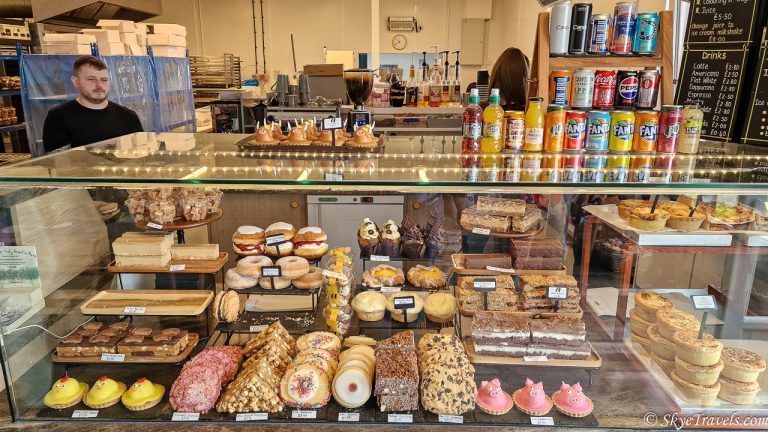As part of the Visit Scotland Expo 2018, I was invited to learn about Charles Rennie Mackintosh, an avant-garde artist and architect behind Glasgow’s Art Deco revival at the turn of the 20th century. We visited the current exhibition at the Kelvingrove Art Gallery and Museum, the uber-exclusive Glasgow Art Club and the soon to be completed Mackintosh at the Willow Tea Rooms.
Who was Charles Rennie Mackintosh
Rennie Mackintosh was a Glaswegian born in 1868. He went on to work for an architectural firm designing some of the more prominent buildings in Glasgow, although not all of his designs were brought to fruition. Two of his most notable works include the Glasgow Art School (currently undergoing restorations from a 2014 fire) and the original Glasgow Herald offices, now known as the Lighthouse. His wife Margaret was also an accomplished artist and helped him design the Miss Cranston Luncheon and Tea Rooms.
Rennie Mackintosh Exhibit at the Kelvingrove Art Gallery and Museum
From 30 March to 14 August 2018, the Kelvingrove Art Gallery and Museum is hosting a special exhibit for Charles Rennie Mackintosh titled Making the Glasgow Style in honor of Mackintosh’s 150th birthday. The Glasgow Style is how Glasgow’s art deco period was referred to.
The exhibit covered more than just Mackintosh. Together with his wife Margaret MacDonald, Margaret’s sister Frances MacDonald and Frances’ husband James Herbert MacNair, they were collectively referred to as The Four. They helped to design and plan buildings across Glasgow, many of which still remain and give the city its unique design.
Mackintosh was involved in much more than just architecture. He was a watercolorist, designer and artist. Among other works of art on display at the museum were the famous high-backed chairs that he designed, stencils he cut for wall patterns, large tapestries and ornate bathroom doors. We had an hour to tour the museum, which was enough time to see everything, if not read every information card.
Mackintosh Designs the Glasgow’s Art Club
The prestigious Glasgow Art Club was founded in 1867 and has been the top hub for artists in Scotland for the past century and a half. We were invited on an exclusive tour of the premises. While the art galleries are available for public tours Mon-Sat, the back rooms and restaurant are for members only.
Our visit started with a lunch in the aforementioned restaurant. The fine dining experience was as unique as the club itself and reminded me of Sean Connery’s scenes in the League of Extraordinary Gentlemen. The room was surrounded by portraits of famous artists. A man in the corner dressed in a brilliant red, long-tailed coat looked to be one of those renowned artists, although none of us wanted to interrupt his meal to get his name.
For the meal, I chose the standard fish and chips. The others had the choice of pork fillet medallions, cock-a-leekie risotto, or cheese, tomato and leek crispy pancakes. The quality of my fish and chips really stood out with its herb flavoring and Budweiser beer batter. Dessert was the choice of a cheese board, or orange, maple and crushed meringue crepes. We were stuffed by the time our tour was ready to begin.
We missed the spring exhibit by a day, but our two tour guides quite thoroughly covered everything from the club membership to how Mackintosh helped design the meeting hall. That hall was by far the most beautiful part of the tour. The wood paneling around the room was ornately carved to Mackintosh’s designs. Two masterpiece fireplaces dominated either end of the room, while a Victorian roof allowed natural lighting for the artwork. Recent renovations had restored Mackintosh’s original artwork and designs. The hour tour was over almost too quickly, but we had one more stop to make.
Restoring the Mackintosh at the Willow
Two minutes from the Glasgow Art Club on Sauchiehall (pronounced suckyhall) is where Rennie and his wife designed gorgeous tea rooms in 1903. Originally called Miss Cranston Luncheon and Tea Rooms and later named the Willow Tea Rooms, the current owner purchased the location in 2014 before the property went to auction. To distinguish it from a new tavern which has capitalized on the name, they renamed the location as the Mackintosh at the Willow, paying proper homage to Rennie.
The premises were not yet open for business, and we were only the second tour to receive access to the construction site. We were first given a private briefing about the work and resources that have gone into restoring the tea rooms and were then led through the premise by the lead contractor. The amount of work which has gone into restoring Mackintosh’s original work was literally mind-blowing.
Calling it a restoration or recreation seems to fall short for what they have achieved. As much of the original elements, such as wood, glass panes and ornamental droplets, fireplaces and moldings, have been left in and restored to their exact original condition. The rest has been replicated with the utmost detail so as to be utterly identical to the original. Measurements were made down to the millimeter, and the most state-of-the-art equipment was used to analyze photographs for colors and designs.
We learned about how they had pulled up carpets to find a tack dating back to 1903 with a single thread of the original carpet still wound around it. By analyzing the thread and studying old records, they were able to recreate the carpet in full, down to the type of weave and quality of the material. In another room, a colored glass panel was missing from the window. They tracked down the original family-owned studio where the windows were cast. The craftsman’s grandson was still in the shop. When he was asked to replicate the glass pane, his response shocked everyone. He had seen a piece of glass resembling the description somewhere in the studio. As it turns out, that piece was an unneeded pane from the original batch used at the Willow Tea Rooms all the way back in 1903!
Rennie Mackintosh and his wife had carte blanche authority to design and decorate the rooms, which they did in true style. Even the menus and waitress uniforms were designed by them. When the Mackintosh at the Willow officially opens its doors on June 7th (Mackintosh’s 150’s birthday), it will look and feel exactly as it did upon its original opening in 1903. You will be able to enjoy an afternoon tea in the same high-backed chairs created by Mackintosh, hold a perfect replica of a Mackintosh-designed teacup and stare at the glass-inlaid artwork along the walls. I look forward to seeing the final product myself.
Click to Pin It!
Visiting Scotland
Looking for more activities to do in Scotland? Check out some of my other articles.
- Begin Your Journey in Scotland with a Secret Food Tour in Edinburgh
- What the Da Vinci Code Didn’t Show You About Rosslyn Chapel
- There’s a Cat Cafe in Edinburgh!
- Enjoying the Happiest Place in Scotland at Edinburgh’s Chihuahua Cafe
- Camera Obscura in Edinburgh Brings Out the Kid in You
- Experience the Underground Preservation of Mary King’s Close
- Escape Edinburgh: The Most Fun Activity in Edinburgh’s New Town
- Finding the Best Ghost Tours in Edinburgh
- 9 Free Attractions to Visit in Edinburgh
- 10 Activities for The Perfect Day Trip from Edinburgh
Here’s some extra reading to save hundreds on your next vacation or stage of your journey.
- 5 Steps to Book Cheap Flights
- Hostels: To Book or Not to Book
- Is Workaway Worth it for the Traveler?
This post may contain affiliate links. These links help give me the wherewithal to continue traveling at no additional cost to you. For more information, click here.

















